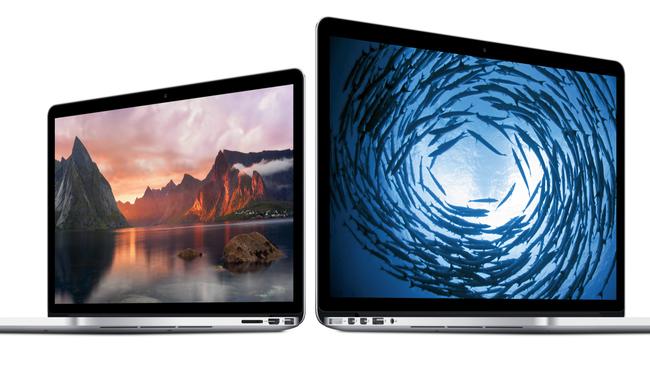Force Touch no doubt a force to be reckoned with
Last week I conducted a little experiment to see how illusionary Apple’s Force Touch feature on its new 13-inch MacBook Pro is.

Last week I conducted a little experiment to see how illusionary Apple’s Force Touch feature on its new 13-inch MacBook Pro actually is.
If you haven’t heard of Force Touch, it’s a feature where you press the trackpad until it clicks and then keep pressing harder and harder until you experience a second, deeper click. Each of these three states, the first click, the continued pressing, and the second click, can trigger three actions — all from a single digit press.
For example, if I select a photo in Finder using the trackpad, then press harder, it gradually enlarges from a thumbnail until it opens fully in “Quick Look” mode at the time of the second click. This one-finger action replaces a combined two-finger click and selection.
So why am I concentrating on a small thing such as a trackpad click?
If you put the pieces together, Forced Touch is destined for most things Apple produces. It’s already available on the MacBook Pro, which I’ve been trialling the past few days. It’s flagged for the upcoming 12-inch MacBook to be released soon, and Apple says a touch screen variant of Force Touch will debut with Apple Watch this month.
Our friends at The Wall Street Journal have reported that the next iPhone models will have Force Touch sensors. From there, it’s not hard to imagine it will find its way to the iPad. That’s most of what Apple makes.
They said in Star Wars: “May the force be with you,” so probably at Apple HQ in Cupertino they will soon say: “May the Force Touch be with you everywhere you go.” Their marketing department will be hoping so.
The first thing to understand about pressing down on the new trackpad and clicking is that it is a totally contrived experience. You’re clicking nothing. It’s smoke and mirrors.
Sure enough, the MacBook Pro returns a click and the usual functionality takes place when you press as normal. When I pressed harder, sensors underneath the trackpad interpreted it as a different request. Press even harder and you cause a second, deeper click.
You feel as if you’ve ratcheted up a notch. In reality, the sensors underneath register you’ve pressed harder and trigger the sending of an illusionary click back to your finger. In effect the trackpad has barely moved.
My little experiment involved switching off a MacBook Air I own and the new 13-inch MacBook Pro on loan. When switched off, the Air’s touchpad clicked as normal as would a mechanical process. Without power, the new MacBook Pro’s trackpad became like a rock: no give, no movement, no haptic feedback, no clicks. That’s because the clicking and haptic (sensory) feedback engines are off. No power, no touchpad.
The Force Touch trackpad virtualises the process. When you press downward, there’s next to no movement. (According to Apple, the movement is limited to 70 microns, or 0.07mm) Instead, sensors below the trackpad sense the pressure and a strangely named “taptic engine” (read haptic) delivers the illusion of a click back to your finger.
On the MacBook Pro in Finder, clicking and then pressing firmly worked best with JPEG images, Pages and Numbers files and PDF files. By clicking, pressing down and registering a second click, I could open files instantly in “quick look” mode, peruse the contents and decide whether to open them completely in Pages or Preview as the case may be.
The usefulness of Force Touch depends on the file type. In Finder, two clicks lets you watch videos almost full screen. It works for. MP4 but not .AVI files. Expect this to work best with Apple formats — naturally.
Placing the cursor on the fast forward button in QuickTime Player or iMovie will speed it up. The same applies to going backward on the backwards button. In Safari, a hard (double) press will open a link up in Quick Look mode. Peruse and click again to view the link as a full page.
A few observations. First, the implementation of the double click is at early stages. Only certain software and file types on a MacBook make use of it. No doubt that will change over time. Second, I found it hard to control the amount of pressure I applied when seeking to preview photos before the second click. It was simpler to click a second time and go into Quick Look mode.
After using Force Touch on the MacBook Pro, I’m not convinced the effort of pressing hard to incrementally enlarge a file works that well, at least on a trackpad. But I think the idea of pressing to force a second click for a preview is a winner.
As for the MacBook Pro itself, you can buy a new 13-inch model with a fifth generation dual-core Intel Core i5 or i7 processor with Force Touch from $1799. Battery life seems pretty good. On my unit, the battery lasted 9 hours 10 minutes playing video at 75 per cent brightness.
So Force Touch is a force to be reckoned with. But it is in its early stages. As for my index finger, it certainly got a workout pressing that trackpad. My index finger muscles are strengthening.
Indeed, eons into the future palaeontologists will report a thickening of the metacarpophalangeal joint of human index fingers from this time. And they’ll be pointing their index digits at Cupertino as the rationale.



To join the conversation, please log in. Don't have an account? Register
Join the conversation, you are commenting as Logout